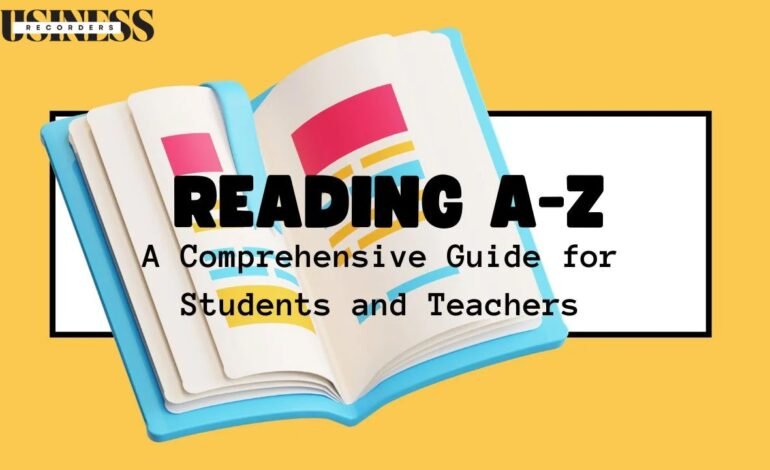
Reading A-Z: A Comprehensive Guide
Reading is one of the most essential skills a child can learn. It opens up a world of knowledge, imagination, and creativity. For parents and teachers, finding effective resources to help children read is crucial. One of these valuable tools is Reading A-Z. This article will answer key questions about Reading A-Z and show its benefits, features, and practical applications.
What is Reading A-Z?
Reading A-Z is an online resource designed to help children improve their reading skills. It provides thousands of books, worksheets, and lesson plans for teachers and parents. The platform focuses on different reading levels, making it easy to find suitable materials for each child’s needs. This allows children to read at their own pace, helping them build confidence and fluency. The website is user-friendly, making it accessible for both educators and students.
Reading A-Z is part of the Learning A-Z family, which also includes resources like Raz-Kids and Science A-Z. These tools provide a well-rounded educational experience for children. With Reading A-Z, children can explore a wide range of topics, which can spark their interest in learning. The platform is used by schools, teachers, and parents worldwide, making it a trusted resource in literacy education.
How Does Reading A-Z Work?
Reading A-Z uses a leveling system to categorize its reading materials. The levels range from A to Z, with A being the easiest and Z being the most challenging. Each level includes books with different themes and topics. Teachers and parents can choose books based on the child’s reading level, interests, and learning goals. This targeted approach helps children develop their reading skills effectively.
The platform provides a vast library of fiction and nonfiction texts. Fiction books include stories, fairy tales, and chapter books, while nonfiction texts cover subjects like science, history, and biographies. This variety allows children to engage with different genres, promoting a well-rounded reading experience.
In addition to books, Reading A-Z offers assessment tools that help track a child’s progress. Teachers can use quizzes and comprehension checks to measure understanding. Parents can also monitor their child’s development through the platform. This ongoing assessment is crucial for identifying areas where a child may need additional support.
What Are the Benefits of Reading A-Z?
Reading A-Z offers many advantages for students, teachers, and parents. Here are some key benefits:
| Benefits | Description |
| Extensive Library | Thousands of books across various reading levels. |
| Customizable Lessons | Teachers can tailor lesson plans to meet students’ needs. |
| Progress Tracking | Tools to monitor each child’s reading development. |
| Engaging Materials | Fun and interesting books that capture children’s attention. |
| Printable Resources | Worksheets and activities that can be printed for offline use. |
| Flexible Access | Can be accessed anytime and anywhere with internet. |
| Supports Various Levels | Books cater to different reading levels from beginner to advanced. |
| High-Quality Content | All materials are carefully curated to ensure educational value. |
These benefits make Reading A-Z a comprehensive resource for enhancing reading skills.
Extensive Library
The vast library of Reading A-Z includes thousands of books that cover a wide range of topics. This diversity helps engage different interests and keeps children motivated to read. With options spanning from animals to space exploration, children can choose topics they are passionate about. This can make the reading experience more enjoyable and encourage a lifelong love of reading.
Customizable Lessons
Teachers can use Reading A-Z to create personalized lesson plans for their students. This means that each child can receive material that fits their learning style and level. By customizing lessons, teachers can ensure that all students are engaged and challenged appropriately. This tailored approach can lead to better learning outcomes, as students are more likely to succeed when working with materials suited to their abilities.
Progress Tracking
Reading A-Z provides tools to monitor each child’s reading development. Teachers can assess comprehension and fluency through quizzes and other assessments. This ongoing evaluation helps identify areas where a child may need extra support. Parents can also track their child’s progress at home, allowing for a collaborative approach to learning.
Engaging Materials
One of the standout features of Reading A-Z is its engaging materials. The books are colorful and well-illustrated, which helps capture children’s attention. Many stories have relatable characters and themes, making it easier for children to connect with what they read. This engagement is vital for fostering a love of reading and encouraging children to read more often.
Printable Resources
Reading A-Z offers printable worksheets and activities that complement the reading materials. These resources provide additional practice and reinforce what children learn. Teachers can use these worksheets in the classroom, and parents can print them for at-home use. This versatility makes Reading A-Z a convenient option for both educators and families.
Flexible Access
One of the key advantages of Reading A-Z is its flexible access. The platform can be accessed anytime and anywhere with an internet connection. This means children can read at home, in the classroom, or even on the go. This flexibility makes it easier for children to fit reading into their daily routines, encouraging consistent practice.
Supports Various Levels
Reading A-Z caters to different reading levels. This ensures that all children, regardless of their current abilities, can find suitable materials. The leveling system helps guide teachers and parents in selecting books that will challenge students without overwhelming them. This tailored approach supports a child’s growth as a reader.
High-Quality Content
All materials on Reading A-Z are carefully curated to ensure educational value. The books are written by experienced authors and are aligned with educational standards. This high-quality content makes Reading A-Z a trusted resource for teachers and parents alike.
How Can Teachers Use Reading A-Z?
Teachers can use Reading A-Z in many ways to support their students’ reading development. Here are some effective strategies:
Assigning Books
Teachers can assign specific books to students based on their reading levels. This ensures that each student receives material that is both challenging and achievable. By assigning books tailored to individual needs, teachers can help students build confidence and improve their skills.
Lesson Plans
Reading A-Z offers a variety of lesson plans that teachers can use in the classroom. These plans are designed to help students practice comprehension and vocabulary skills. Teachers can choose from various activities, such as group discussions and individual assignments, to reinforce learning.
Group Reading Activities
Teachers can organize group reading activities using Reading A-Z materials. By grouping students with similar reading levels, teachers can facilitate discussions and collaborative learning. This encourages students to share their thoughts and ideas, fostering a sense of community in the classroom.
Progress Monitoring
Teachers can use Reading A-Z’s assessment tools to evaluate their students’ progress regularly. By conducting quizzes and comprehension checks, teachers can identify areas where a child may need additional support. This ongoing assessment helps ensure that all students are progressing in their reading skills.
Parental Involvement
Teachers can encourage parental involvement by providing parents with information about Reading A-Z. By sharing resources and strategies, teachers can help parents support their children’s reading development at home. This collaboration between teachers and parents can enhance a child’s learning experience.
How Can Parents Use Reading A-Z?
Parents play a crucial role in their children’s reading development. With Reading A-Z, parents can support their children at home in various ways:
Choosing Books
Parents can help their children choose books that match their interests and reading levels. By selecting engaging topics, parents can make reading enjoyable for their children. This encourages children to read more often and develop a love for books.
Printing Resources
Reading A-Z offers printable worksheets and activities that parents can use at home. These resources provide additional practice and reinforce what children learn in school. By using these materials, parents can create a structured reading routine that supports their child’s learning.
Setting a Reading Schedule
Parents can establish a reading schedule at home. By setting aside dedicated time for reading, parents can help their children develop good habits. This routine can create a sense of consistency and make reading a regular part of their day.
Engaging in Discussions
Parents can engage their children in discussions about the books they read. Asking open-ended questions encourages children to think critically about the material. This practice helps improve comprehension skills and allows parents to better understand their child’s interests.
Encouraging Independence
As children become more confident readers, parents can encourage them to choose their own books from Reading A-Z. This independence allows children to explore topics they are passionate about, fostering a sense of ownership over their reading journey.
What Makes Reading A-Z Stand Out?
Reading A-Z has several unique features that make it an exceptional resource for teaching reading. Here are some of the key aspects that set it apart:
Diverse Library
One unique feature of Reading A-Z is its diverse library. The platform includes books on various topics, such as science, history, and fiction. This diversity helps engage different interests and keeps children motivated to read. By offering materials that appeal to a wide range of students, Reading A-Z supports a love for reading among children.
Personalized Reading Materials
Another standout feature is the ability to create personalized reading materials. Teachers and parents can customize lesson plans and activities based on the child’s needs. This level of personalization sets Reading A-Z apart from other reading resources. By tailoring materials to fit individual students, educators can enhance the learning experience.
Interactive Learning
Reading A-Z includes interactive elements that engage children while they read. Some books come with audio options that allow children to listen as they follow along. This can help reinforce pronunciation and comprehension skills, making reading more enjoyable.
Professional Development Resources
Reading A-Z also offers professional development resources for teachers. This includes webinars, articles, and guides on effective teaching strategies. By providing educators with the tools they need, Reading A-Z supports ongoing professional growth in literacy instruction.
What Are the Challenges of Using Reading A-Z?
While Reading A-Z has many benefits, it also has some challenges. Here are some of the common issues users may encounter:
Subscription Cost
One challenge is that access requires a subscription. This might be a barrier for some families and schools. However, many educational institutions find that the benefits of using Reading A-Z outweigh the costs, making it a worthwhile investment.
Overwhelming Choices
Another challenge is that some users may find the vast library overwhelming. With so many choices, it can be hard to know where to start. To overcome this, teachers and parents can focus on specific levels and themes when selecting books.
Technology Requirements
Reading A-Z is an online platform, which means users need access to the internet. For families without reliable internet access, this can pose a challenge. However, the platform does offer printable materials that can be used offline.
How Can Reading A-Z Support Different Learning Styles?
Reading A-Z caters to different learning styles, making it a versatile resource. Here’s how it supports various types of learners:
Visual Learners
Visual learners can benefit from the colorful illustrations in the books. The engaging visuals help capture their attention and aid comprehension. By providing a stimulating reading experience, Reading A-Z supports visual learners effectively.
Auditory Learners
Auditory learners can listen to the audio versions of the texts, which enhances their understanding. This option allows them to hear proper pronunciation and rhythm while following along in the text. This auditory support is crucial for developing reading fluency.
Kinesthetic Learners
Kinesthetic learners can engage with printable activities that promote hands-on learning. Activities such as word puzzles and games provide opportunities for movement and interaction. By incorporating physical elements into the learning process, Reading A-Z supports kinesthetic learners.
Independent Learners
Reading A-Z promotes independence by allowing children to choose their own books and read at their own pace. This autonomy encourages self-directed learning and helps children develop a sense of responsibility for their education.
Conclusion
Reading A-Z is an excellent resource for improving reading skills in children. Its extensive library, customizable lessons, and progress tracking tools make it a valuable tool for teachers and parents alike. While there are some challenges, the benefits far outweigh them. By incorporating Reading A-Z into their teaching or parenting strategies, educators and families can help children develop a love for reading. This love will last a lifetime, paving the way for their success in school and beyond.
In summary, Reading A-Z is a powerful tool that supports literacy development. Whether used in the classroom or at home, it provides a wealth of resources that can meet the diverse needs of learners. As children engage with the materials, they will gain confidence in their reading abilities, setting a solid foundation for their future academic success.












